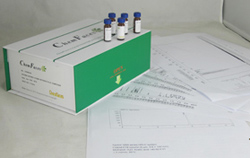Hot Products



| Catalog No. | Information |
| CFN98193 | 2-Hydroxycinnamic acid 2-Hydroxycinnamic acid has photooxidant activity; 2-hydroxycinnamic acid germanium has strong inhibitory effect on the tumor U14; trans-2-hydroxycinnamic acid has efficacy against trichlorfon-induced oxidative stress in wistar rats. |
| CFN97687 | 2'-Hydroxydaidzein 2'-Hydroxygenistein is an isoflavonoid phytoalexin, it suppresses chemical mediators in inflammatory cells, may have value in treatment and prevention of central and peripheral inflammatory diseases associated with excess production of chemical mediators. 2'-Hydroxygenistein shows significant concentration-dependent inhibitory effects on the release of beta-glucuronidase and lysozyme from rat neutrophils in response to formyl-Met-Leu-Phe/cytochalasin B (fMLP/CB) with IC(50) values of 2.8+/-0.1 and 5.9+/-1.4 microM, respectively. |
| CFN90346 | 2-Hydroxyeupatolide 2-Hydroxyeupatolide has anti-inflammatory activity,it may suppress the inflammatory response through inhibiting the activation of NF-κB signaling pathways, and make a contribution to further understanding the pharmaceutical activity of Eupatorium plants. |
| CFN99257 | 2'-Hydroxygenistein 2'-Hydroxygenistein has antifungal activity, dimerization of it causes a remarkable increase of antifungal activity. It shows significant concentration-dependent inhibitory effects on the release of beta-glucuronidase and lysozyme from rat neutrophils in response to formyl-Met-Leu-Phe/cytochalasin B. 2'-Hydroxygenistein of genistein can enhance its antioxidant activity and cell cytotoxicity in MCF-7 human breast cancer cells. |
| CFN97950 | 2-Hydroxynaringenin The recombinant protein exhibits high FNS I activity catalyzing the conversion of naringenin to apigenin and 2-Hydroxynaringenin. |
| CFN95197 | 2-Methoxy-5-acetoxy-furanogermacr-1(10)-en-6-one Reference standards. |
| CFN98192 | 2-Methoxycinnamic acid 2-Methoxycinnamic acid is a photosensitive compound. 2-Methoxycinnamic acid can enhance inhibition of tyrosinase activity. |
| CFN92004 | 2'-Methoxykurarinone 2'-Methoxykurarinone has strong alpha-glucosidase inhibitory activities, with IC(50) values of 155 microM. 2'-Methoxykurarinone is a noncompetitive inhibitor of protein tyrosine phosphatase 1B, it exhibits cellular activity in the insulin signaling pathway by increasing the insulin-stimulated Akt phosphorylation level in human hepatocellular liver carcinoma HepG2 cells, suggesting its potential for new anti-insulin-resistant drug developments. 2′-Methoxykurarinone exhibits lethal activity against Trypanosoma cruzi.,the minimum lethal concentrations is 6.9 uM. |
| CFN97412 | 2-Methoxystypandrone 2-Methoxystypandrone displays an immunomodulatory effect in a cellular model, it blocks inflammatory responses by impairing NF-κB signaling to limit the inflammation and oxidative stress for preservation of BBB integrity. 2-Methoxystypandrone concomitantly promotes neurodevelopmental protein expression and endogenous neurogenesis through inactivation of GSK3β to enhance β-catenin signaling for upexpression of neuroprotective genes and proteins.2-Methoxystypandrone has anti-osteoclastogenic effect, could reflect the block of RANKL-induced association of TRAF6-TAK1 complexes with consequent decrease of IkappaB-mediated NF-kappaB and mitogen-activated protein kinases-mediated c-Fos activation pathways and suppression of NFATc1 and other gene expression, essential for bone resorption. |
| CFN92353 | 2''-O-acetyl-platyconic acid A Reference standards. |